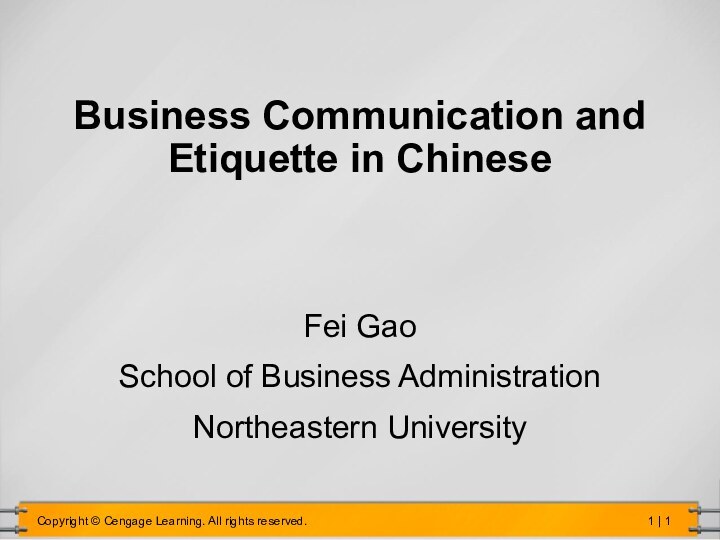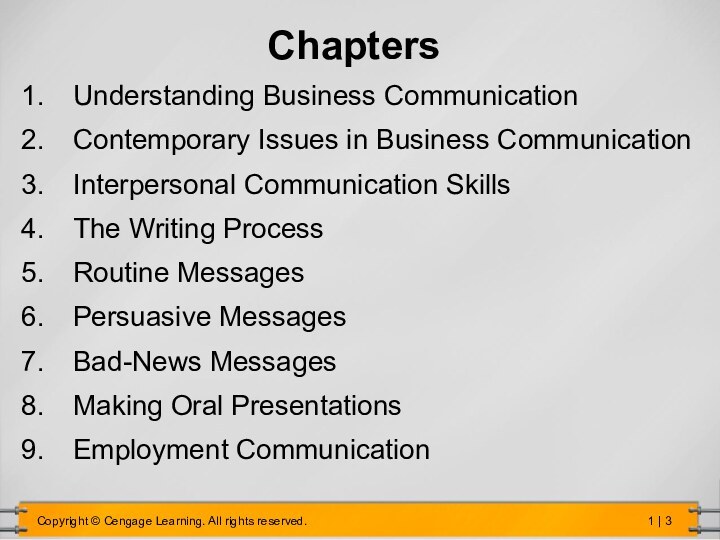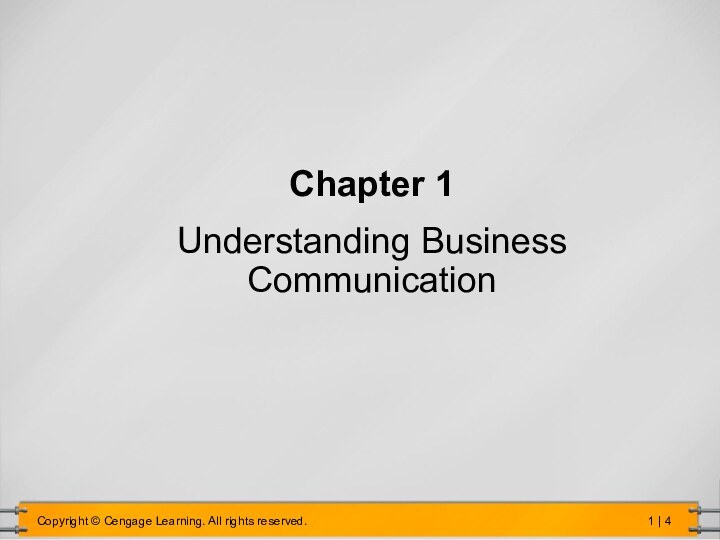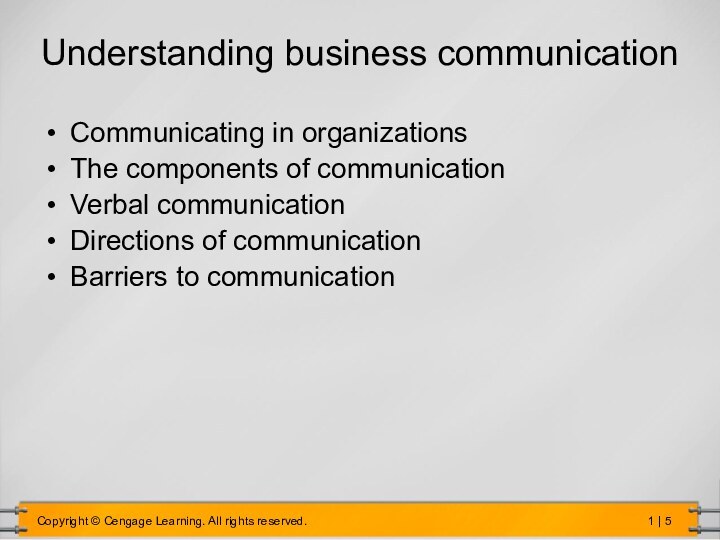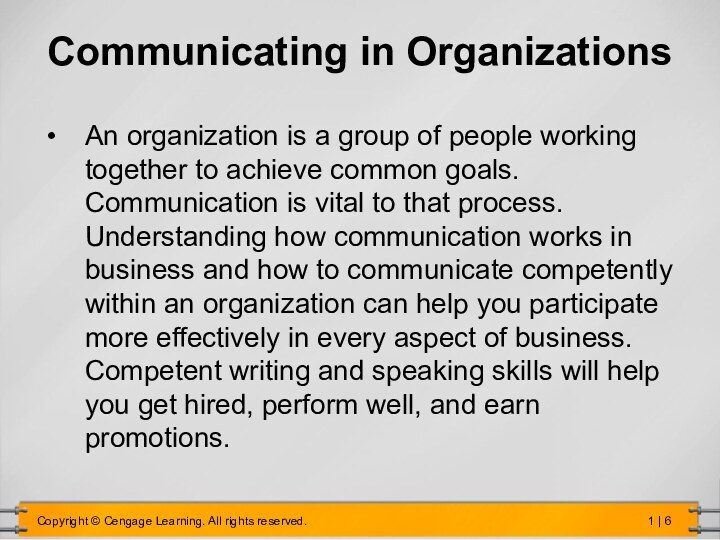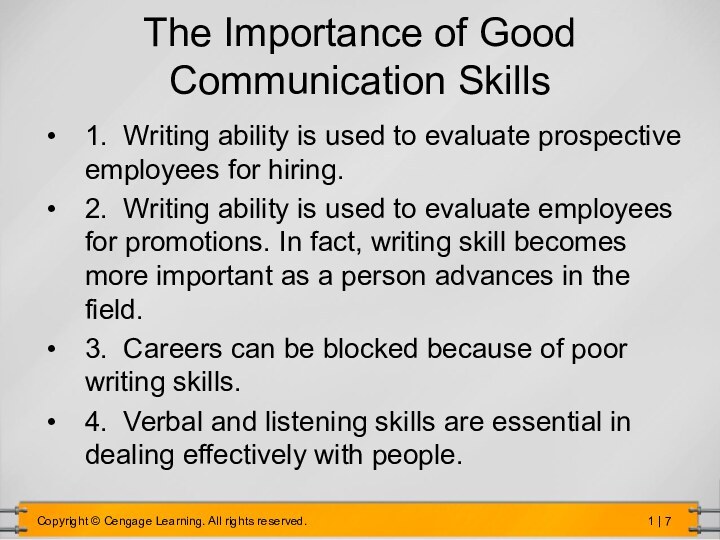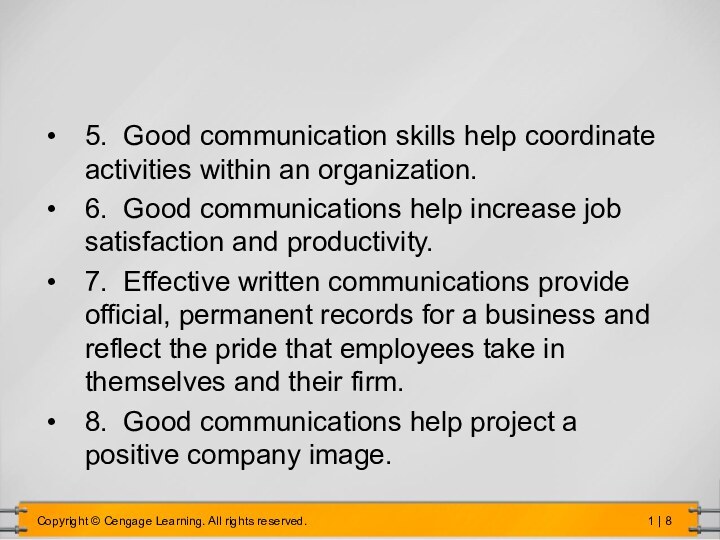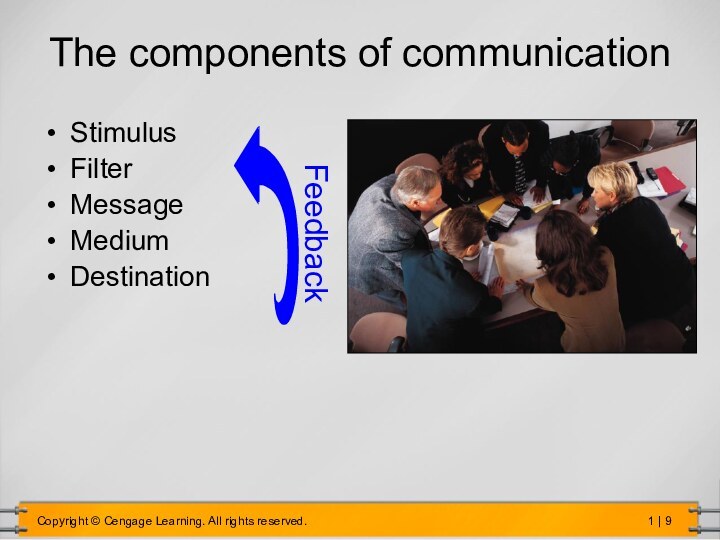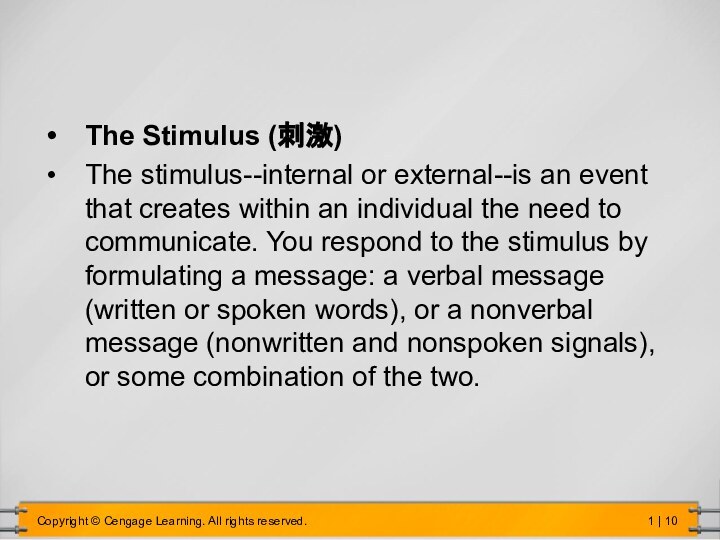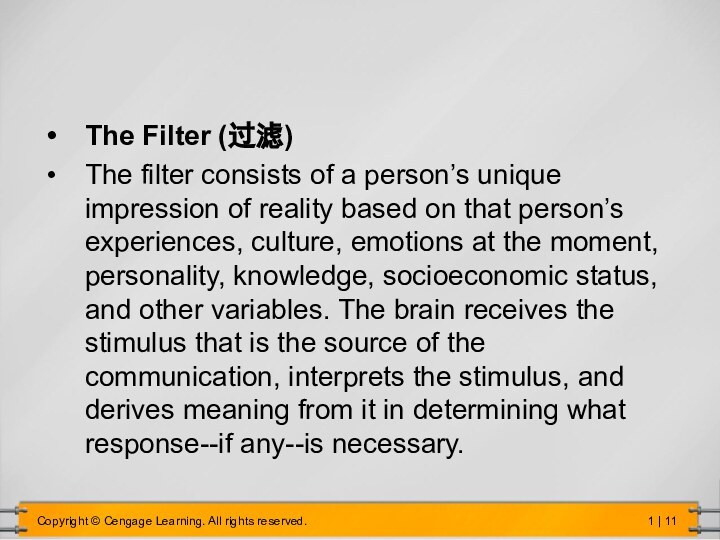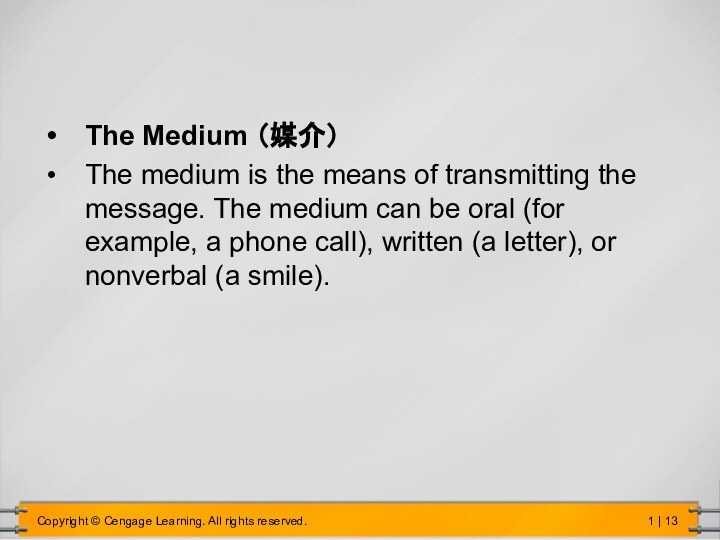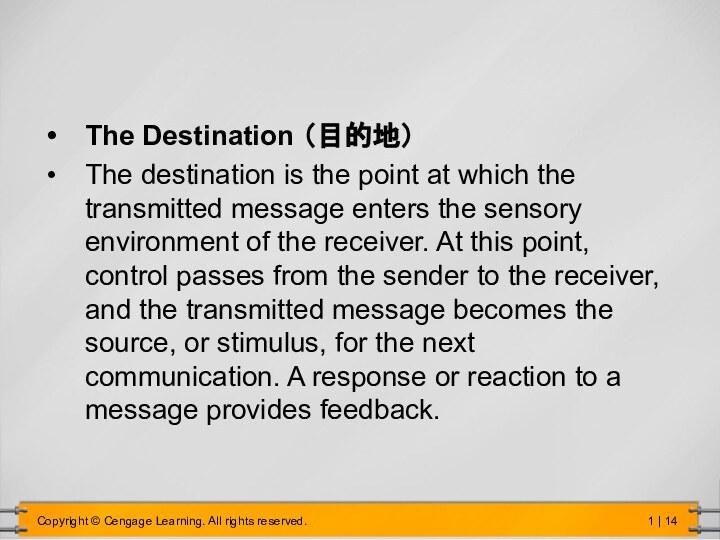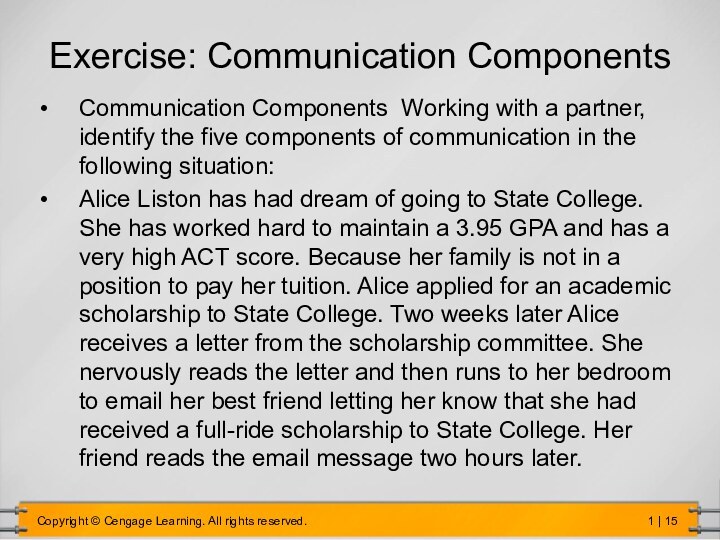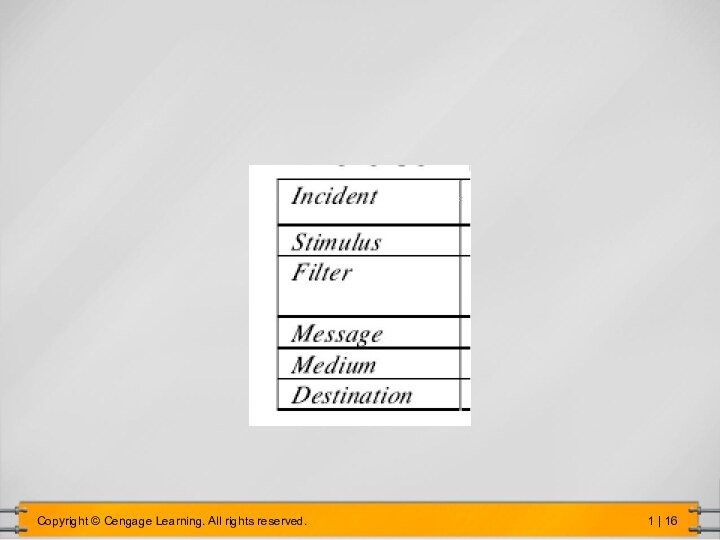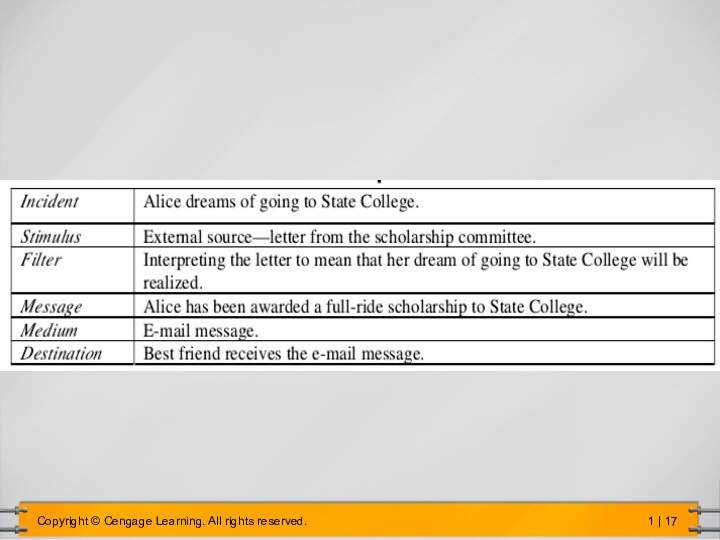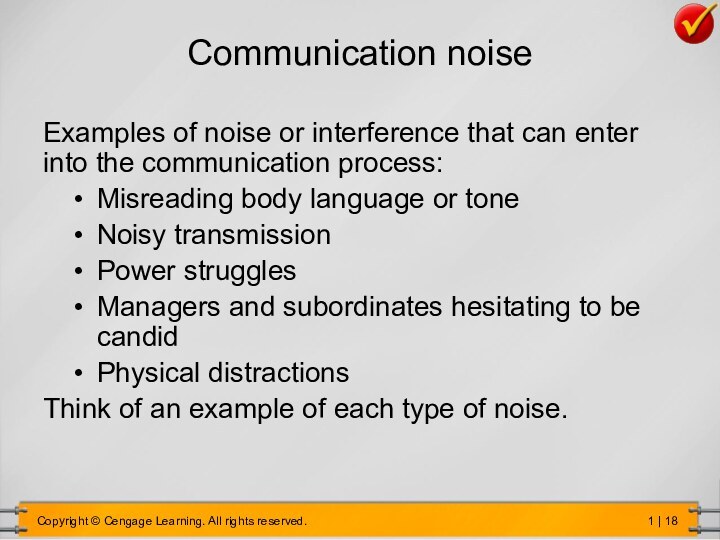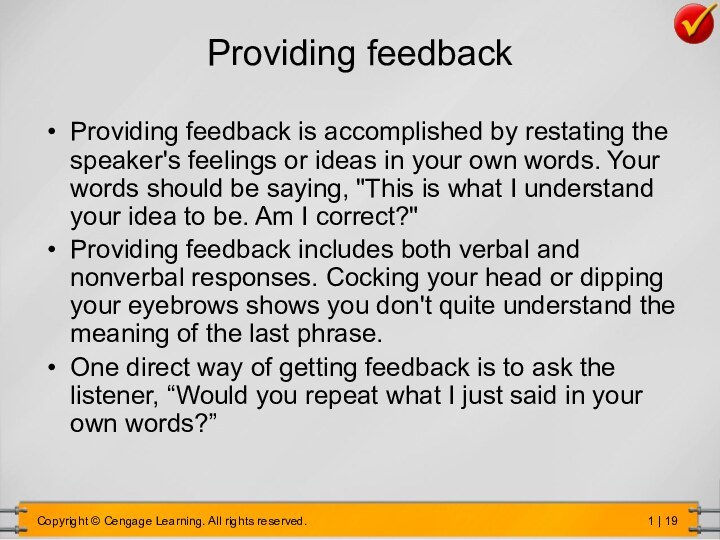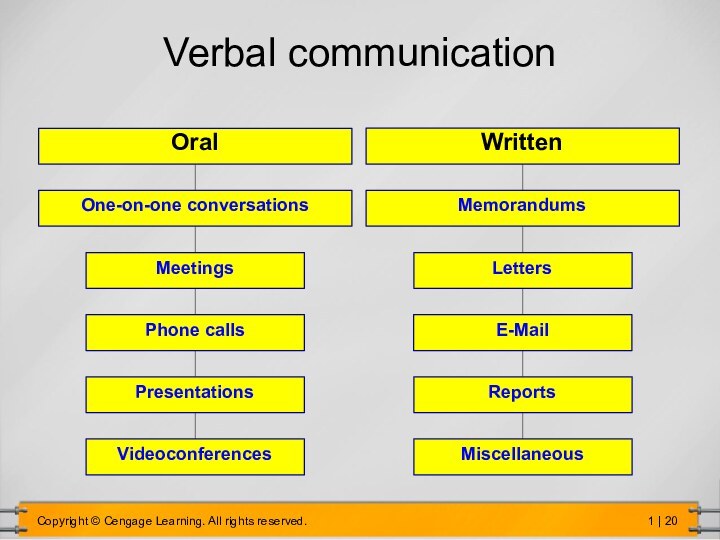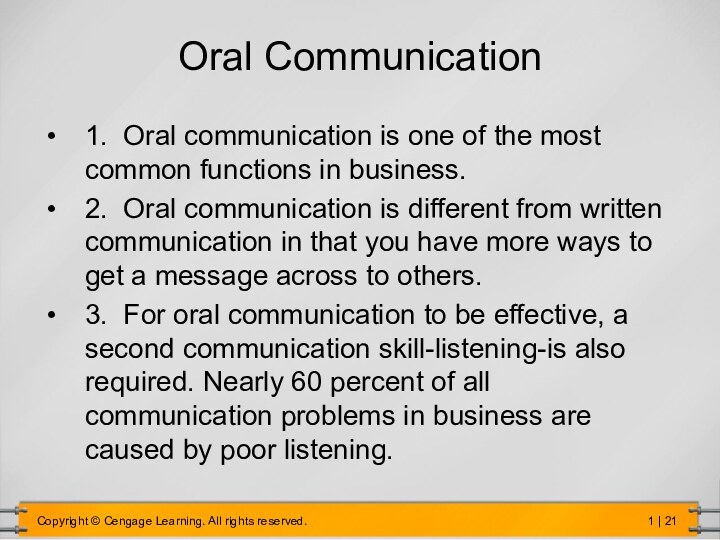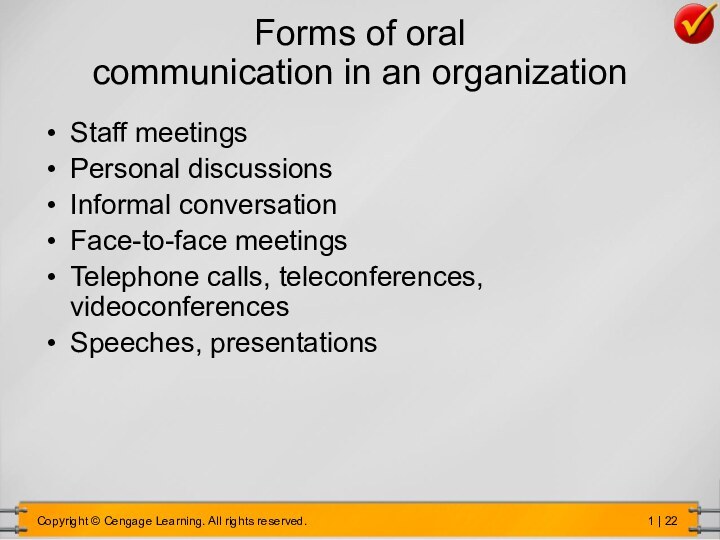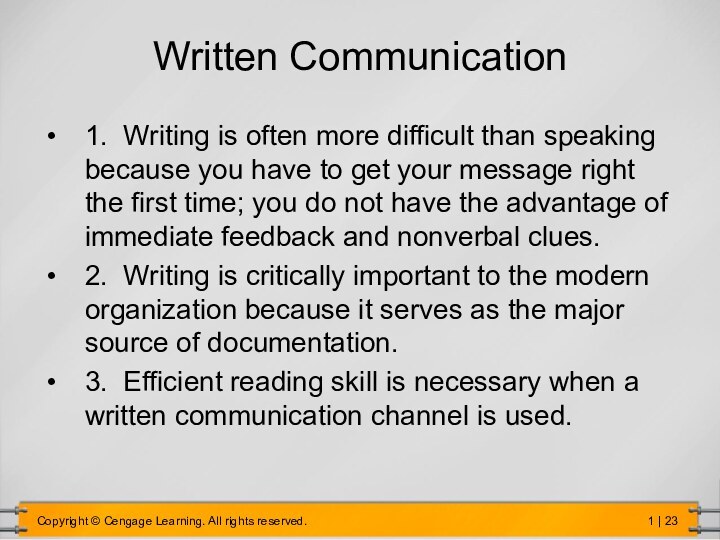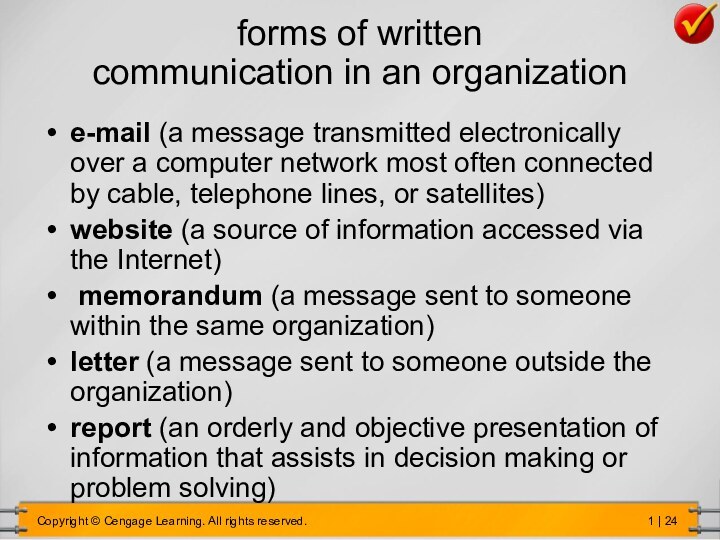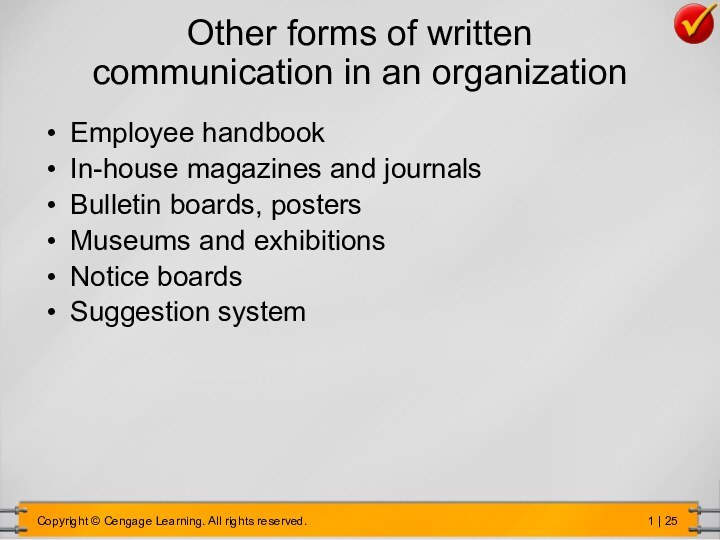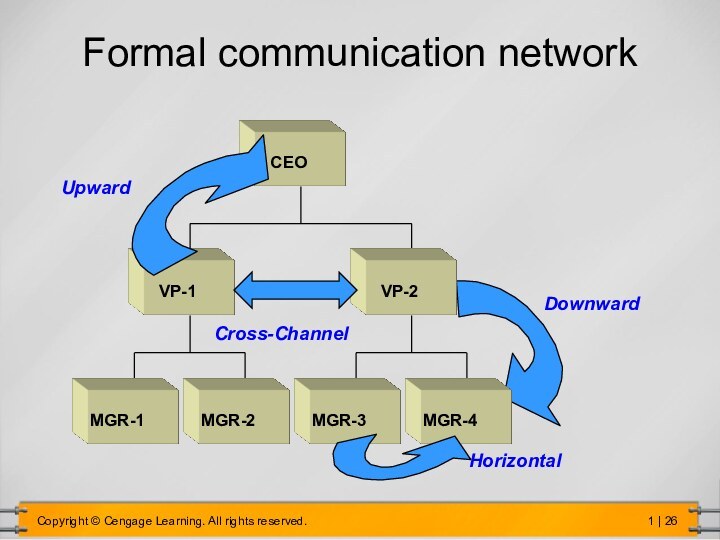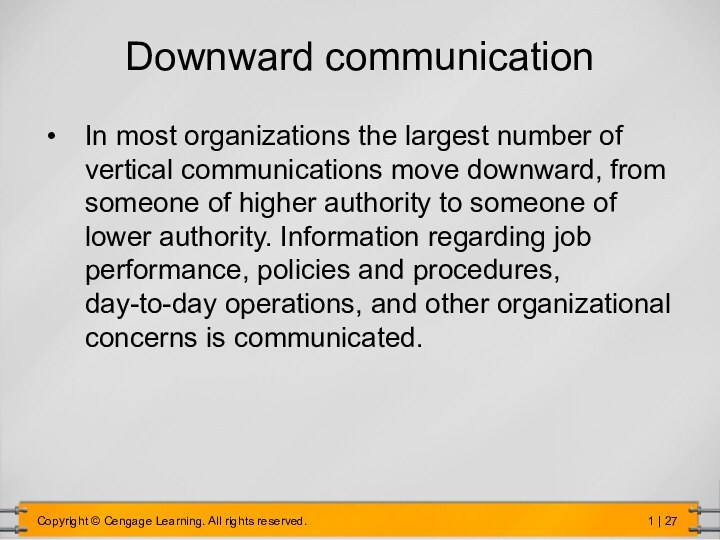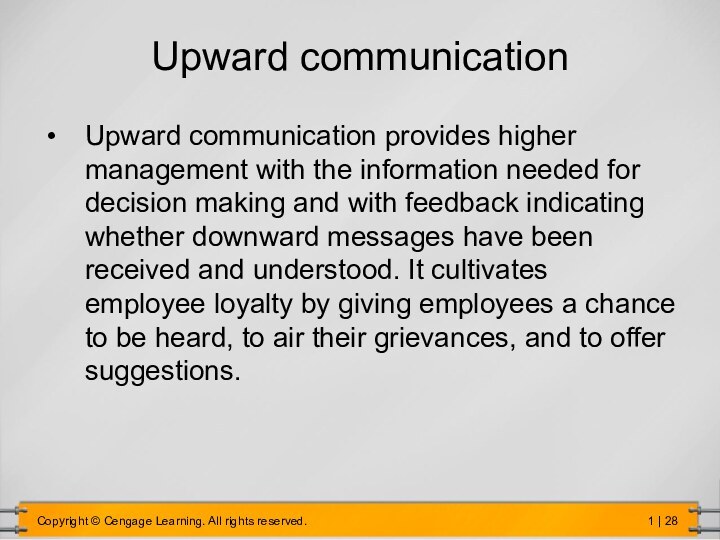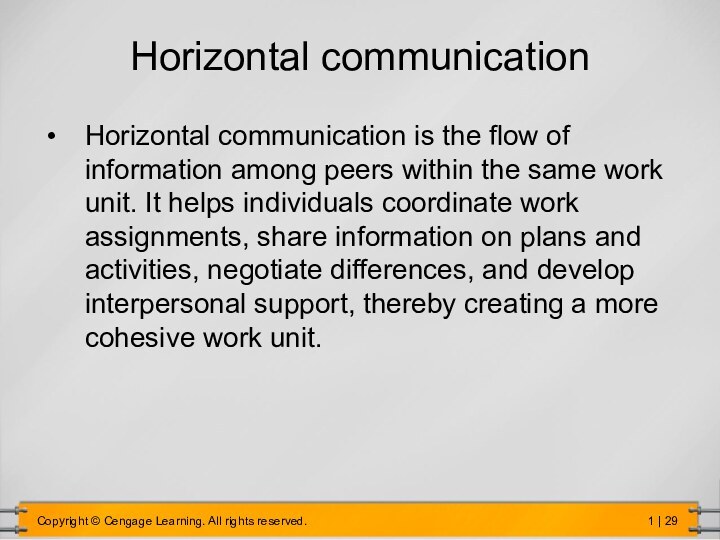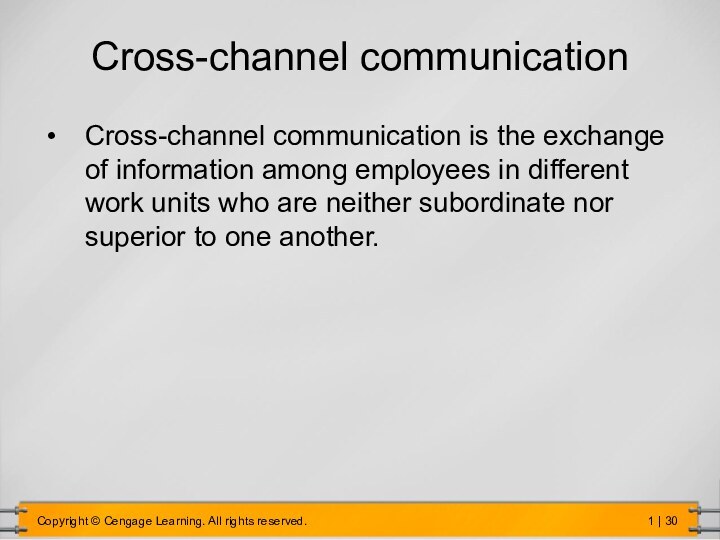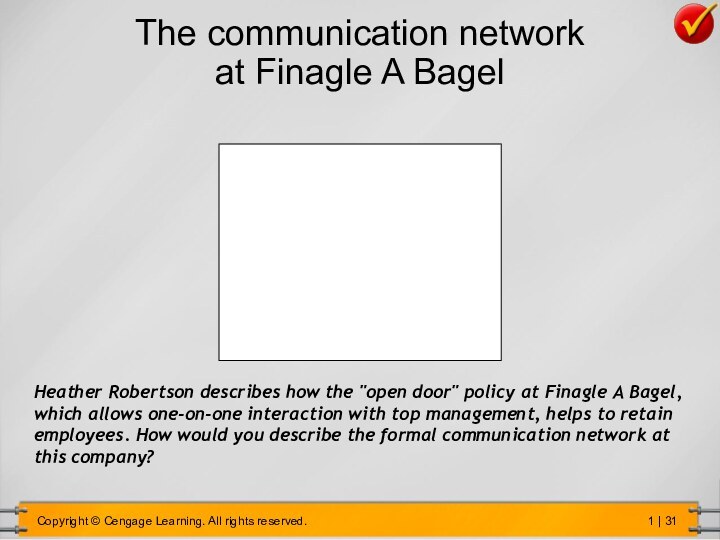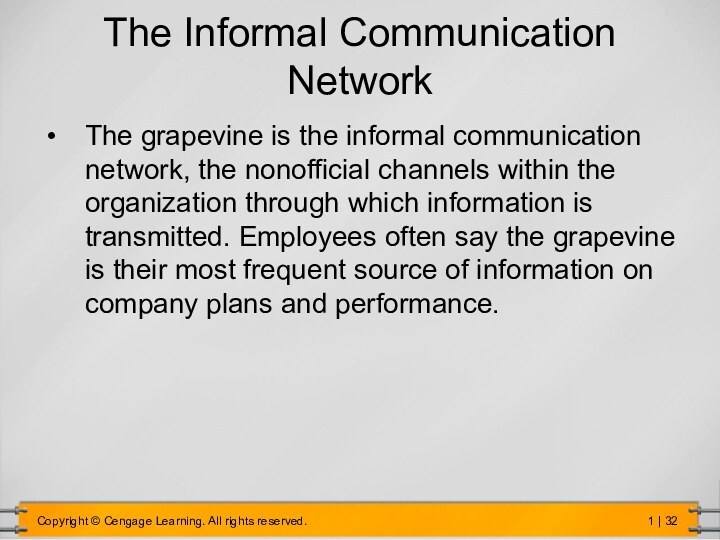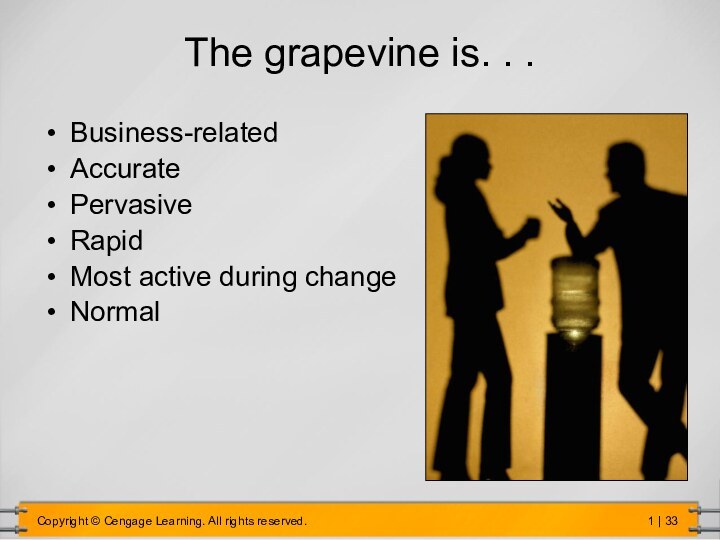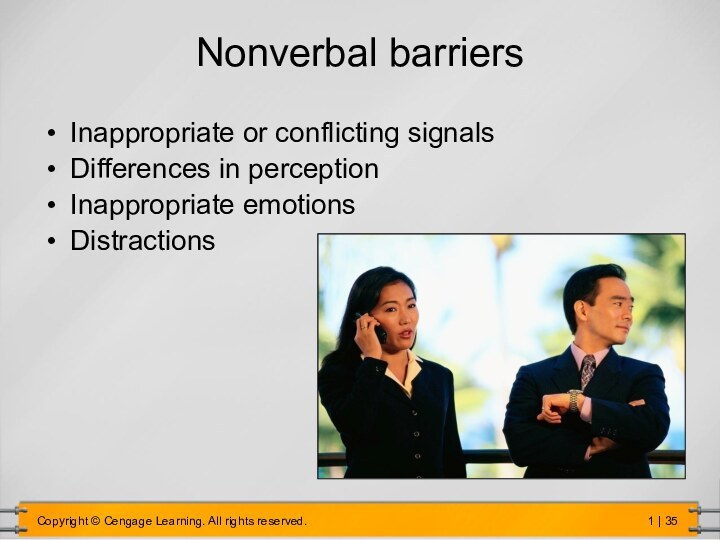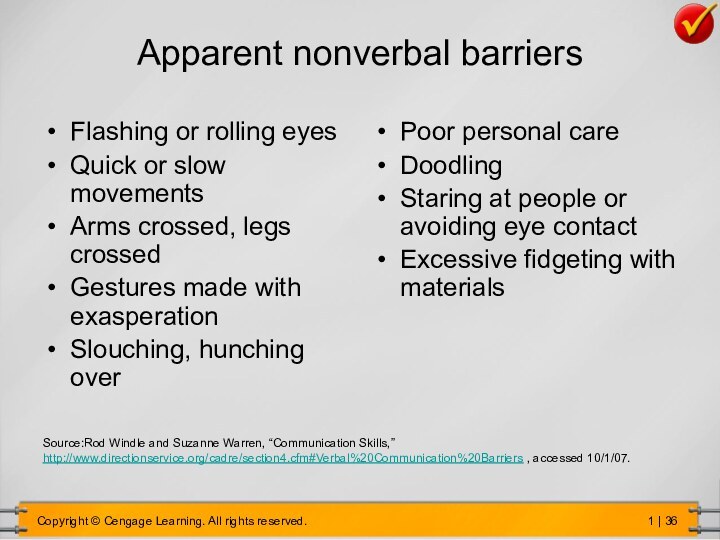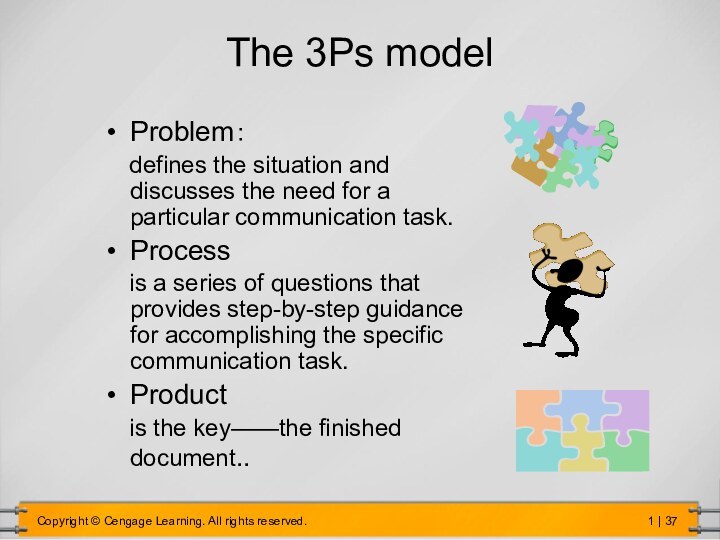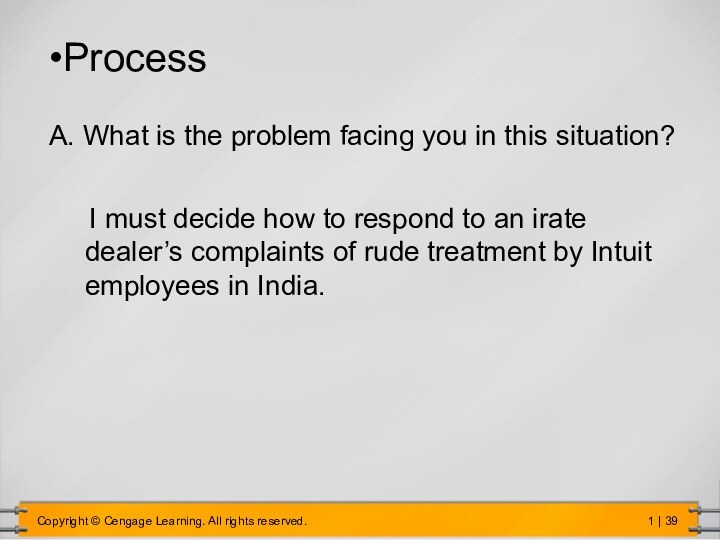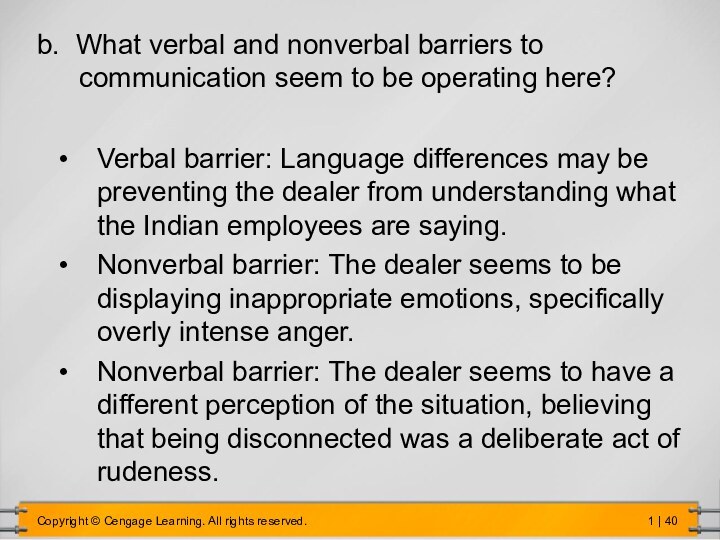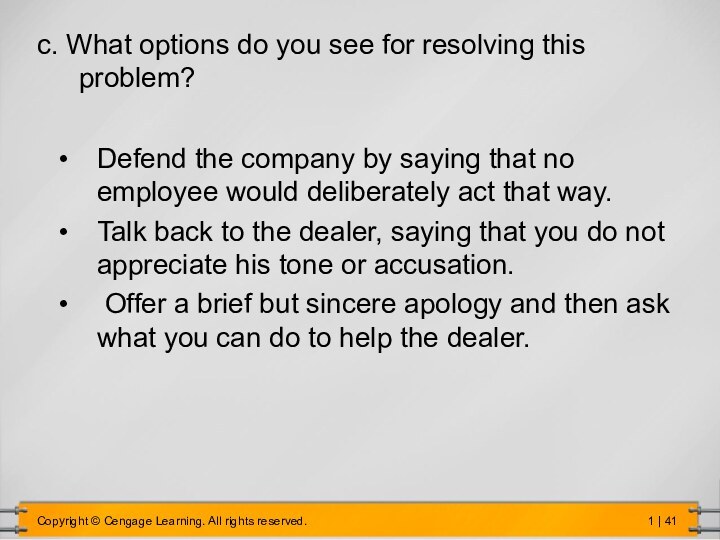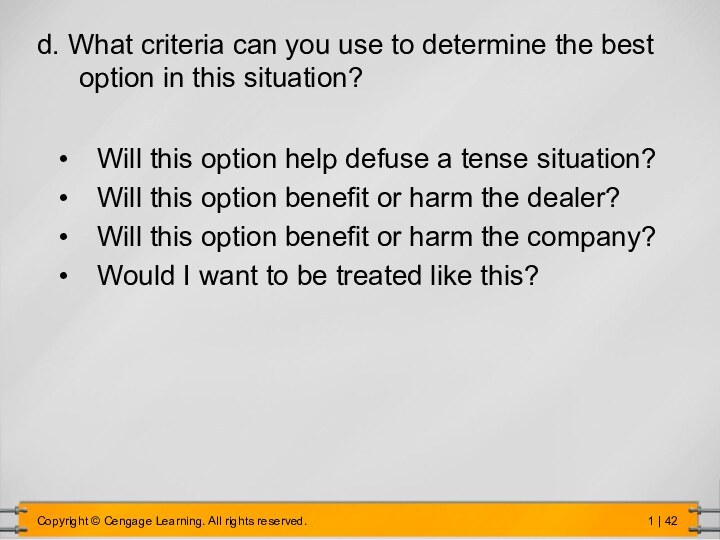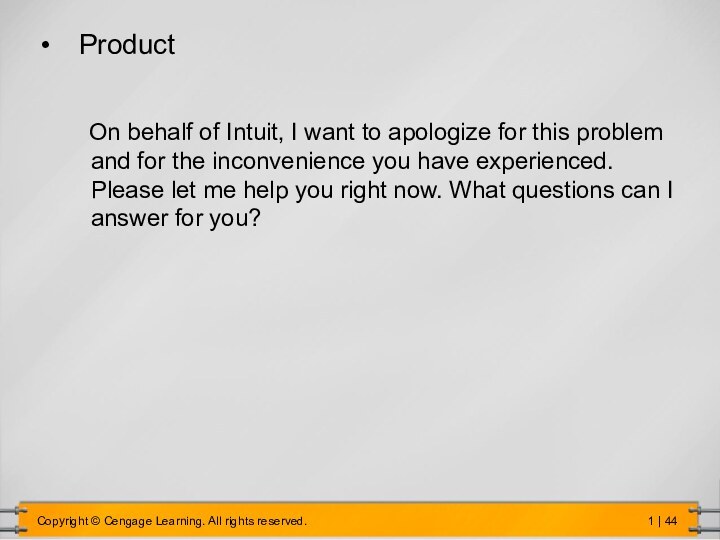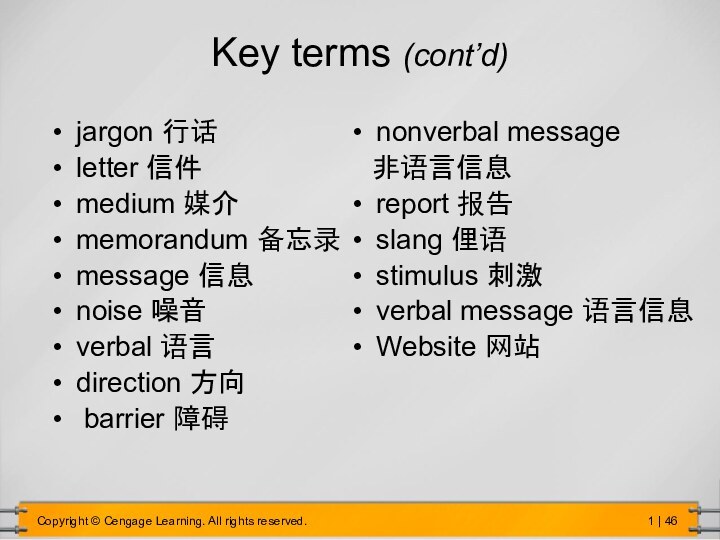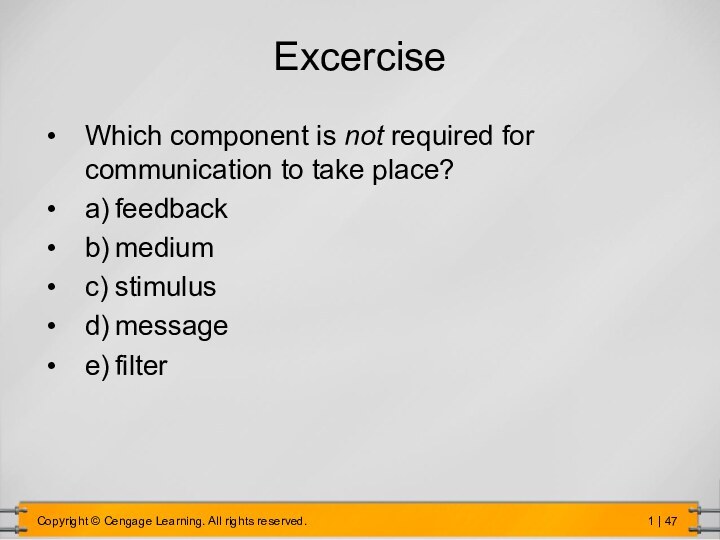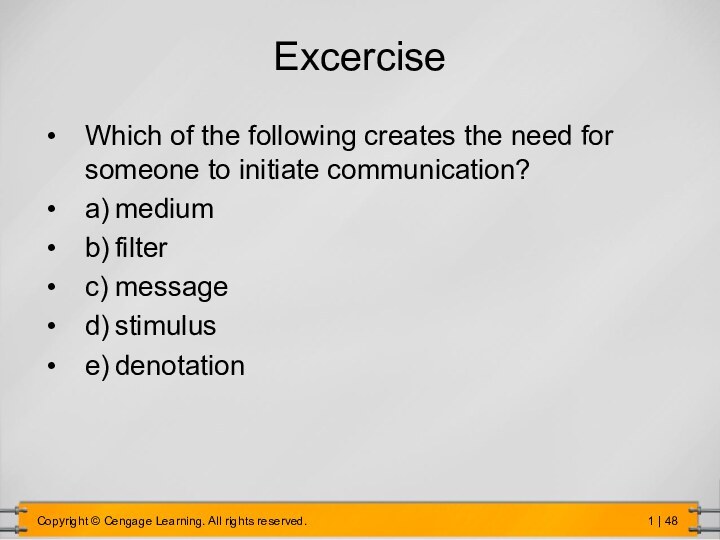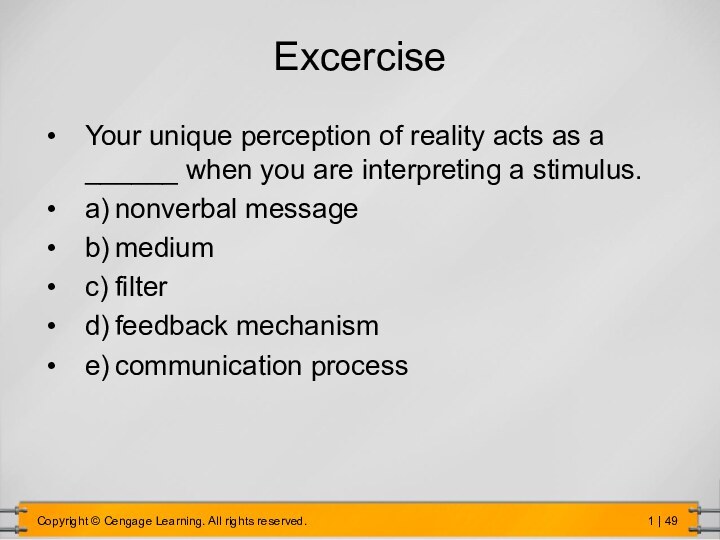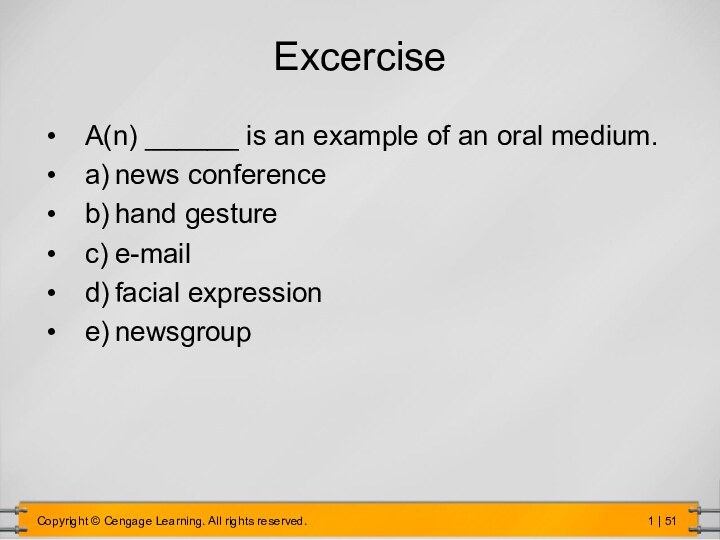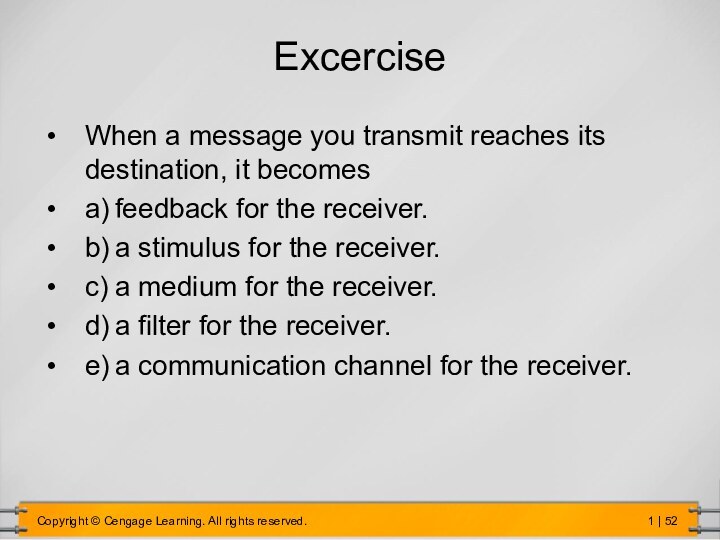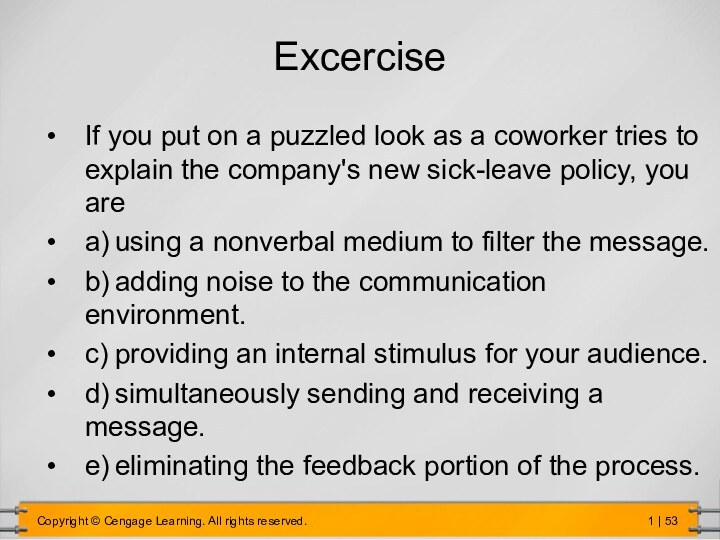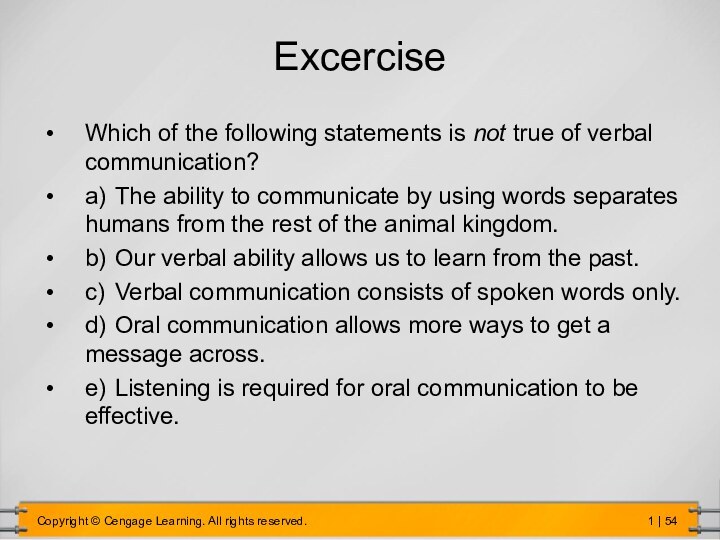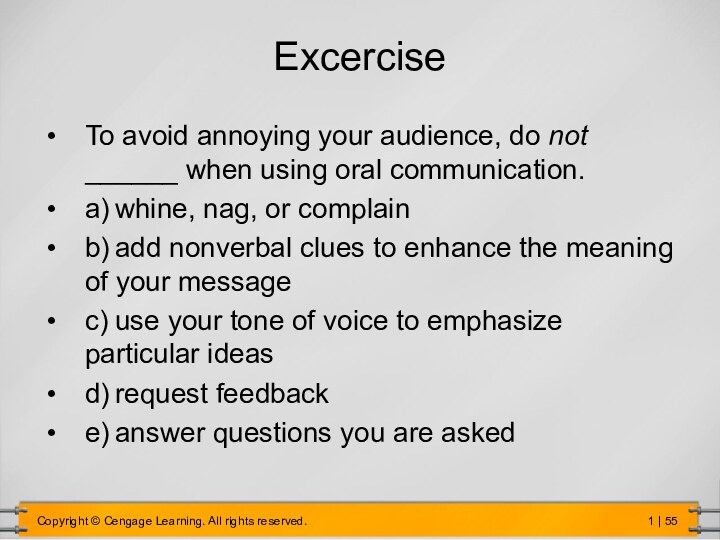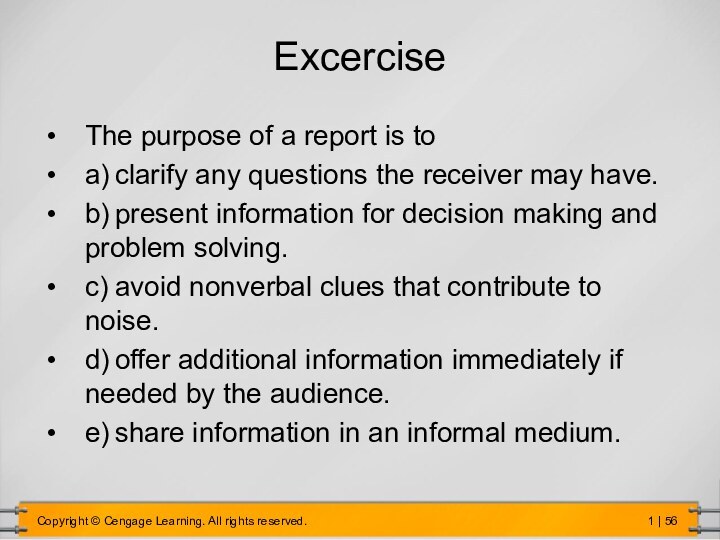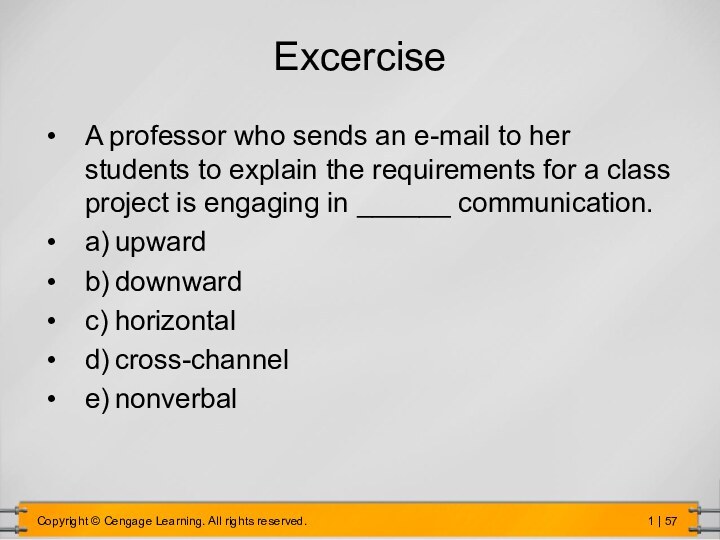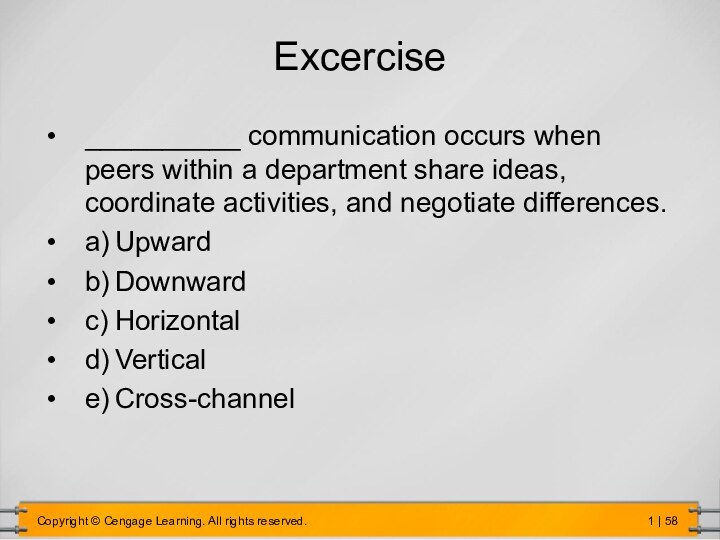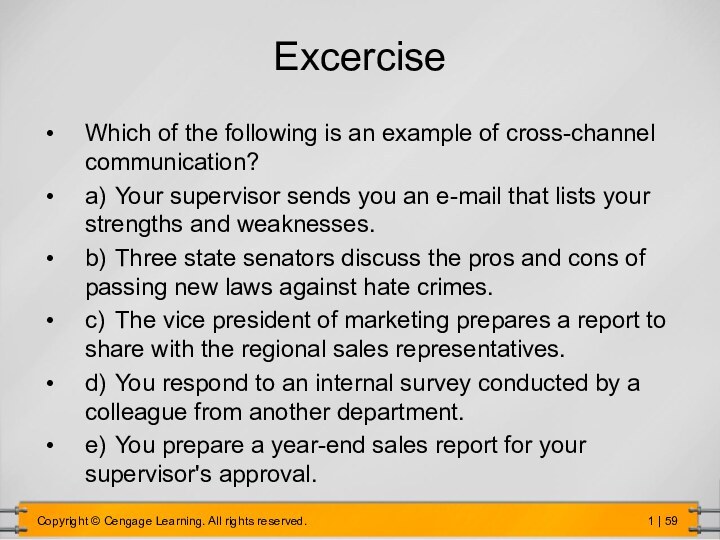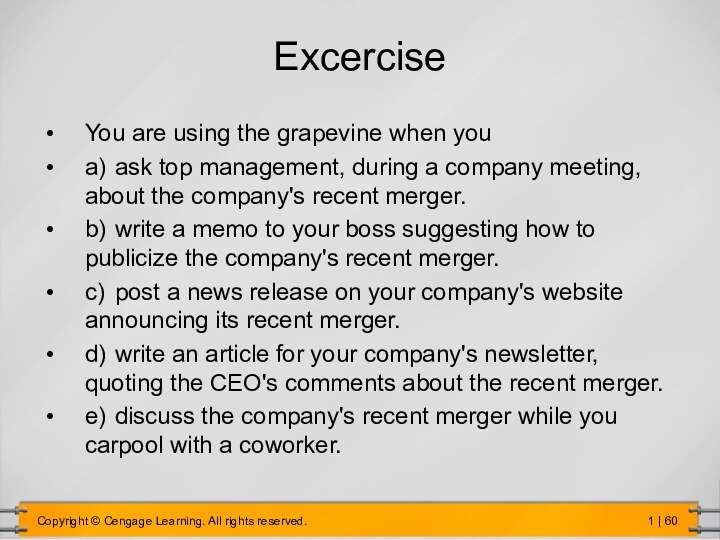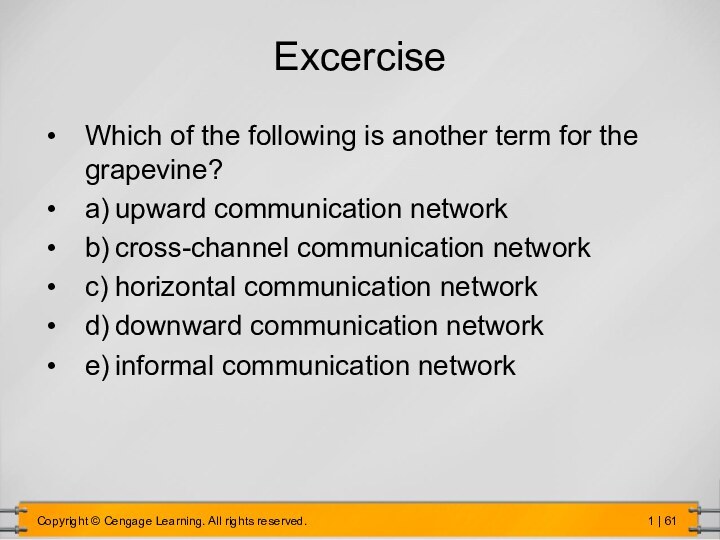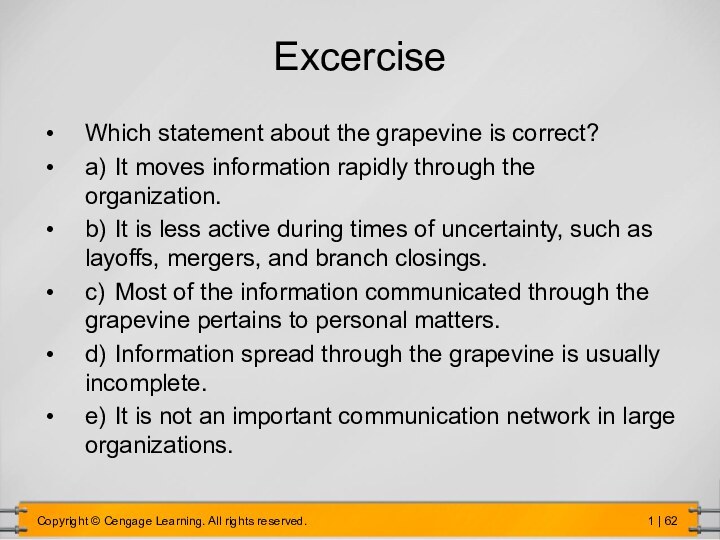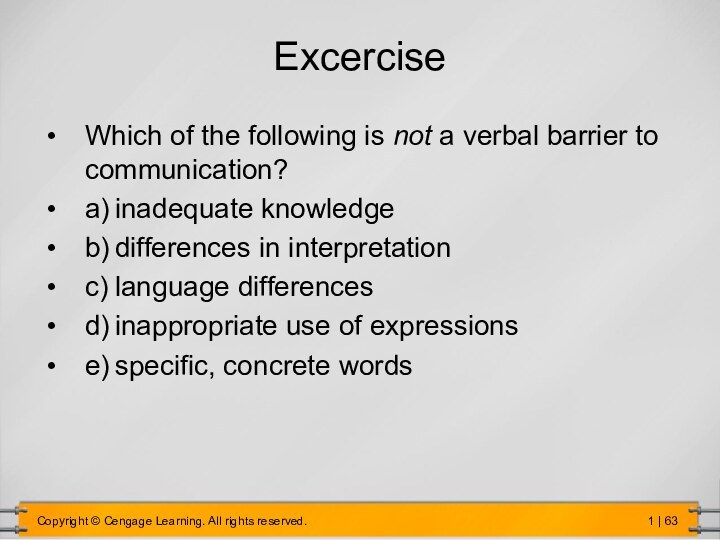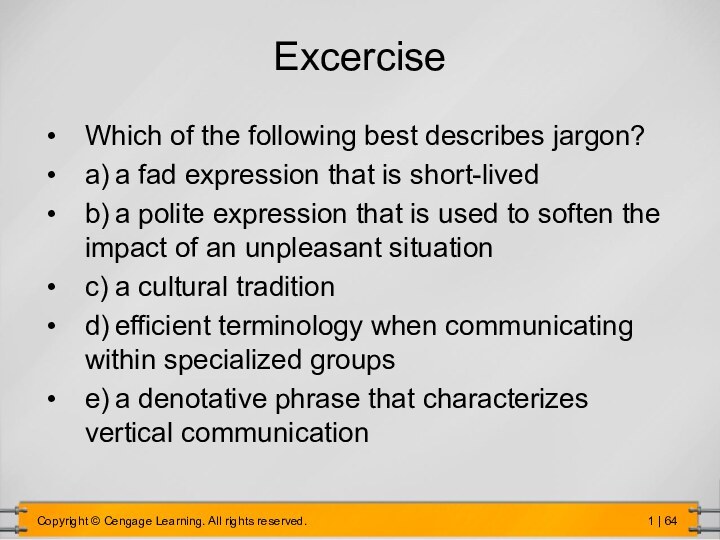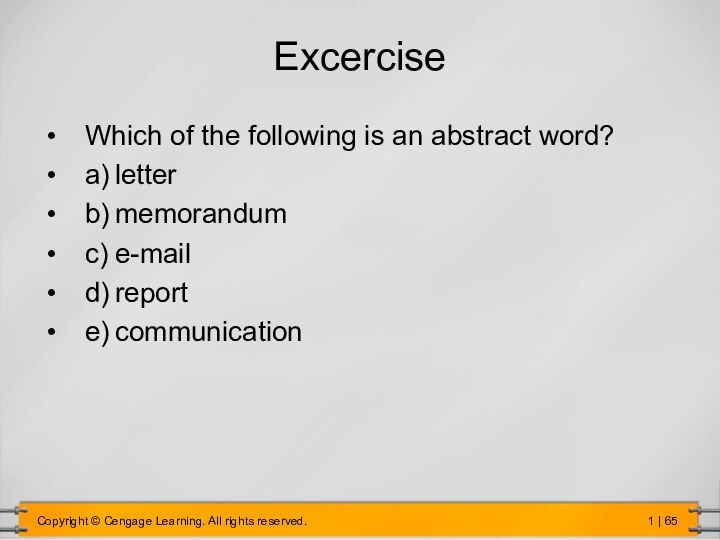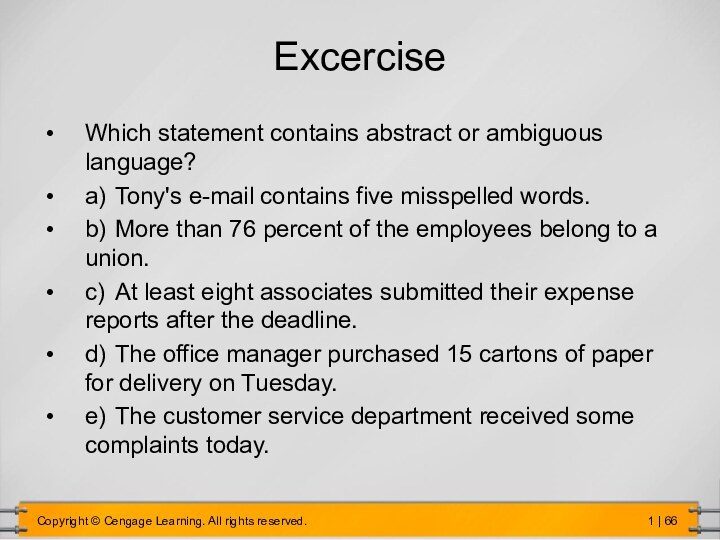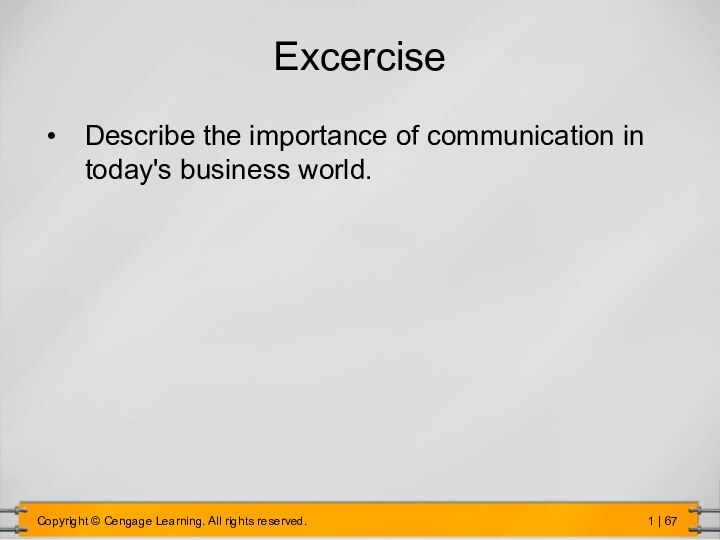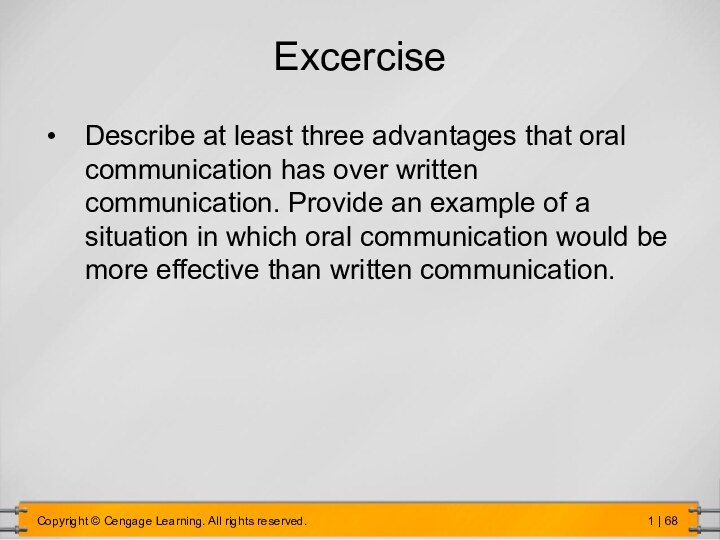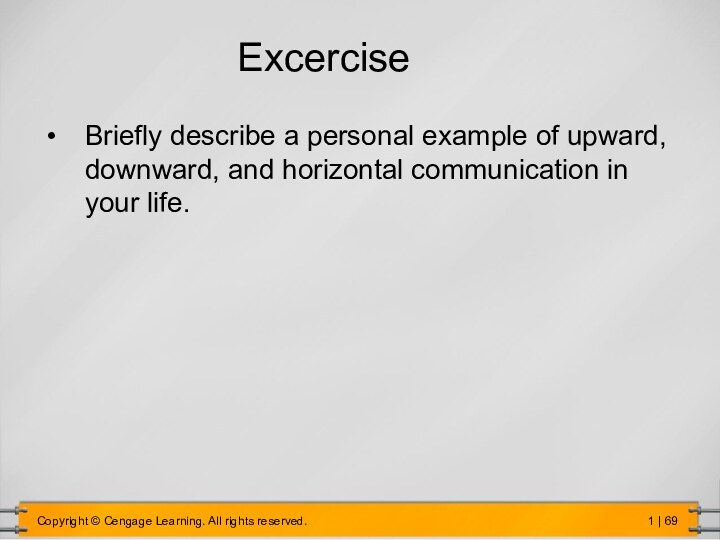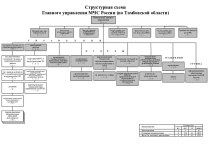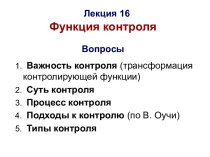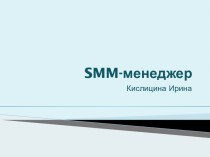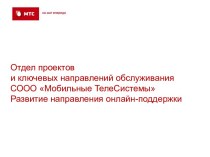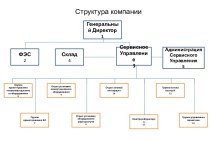Слайд 2
NAME:Fei Gao
AFFILIATION:Department of Industrial Economics, School of Business
Administration, Northeastern University
ADDRESS:
No.500, Zhihui Street, Hunnan District, Shenyang, Liaoning,
110169, China
MOBILE PHONE:
0086-13614026608
0086-18640067789
E-MAIL:
fgao@mail.neu.edu.cn
Слайд 3
Chapters
Understanding Business Communication
Contemporary Issues in Business Communication
Interpersonal Communication
Skills
The Writing Process
Routine Messages
Persuasive Messages
Bad-News Messages
Making Oral Presentations
Employment Communication
Слайд 4
Chapter 1
Understanding Business Communication
Слайд 5
Understanding business communication
Communicating in organizations
The components of communication
Verbal
communication
Directions of communication
Barriers to communication
Слайд 6
Communicating in Organizations
An organization is a group
of people working together to achieve common goals. Communication
is vital to that process. Understanding how communication works in business and how to communicate competently within an organization can help you participate more effectively in every aspect of business. Competent writing and speaking skills will help you get hired, perform well, and earn promotions.
Слайд 7
The Importance of Good Communication Skills
1. Writing
ability is used to evaluate prospective employees for hiring.
2. Writing ability is used to evaluate employees for promotions. In fact, writing skill becomes more important as a person advances in the field.
3. Careers can be blocked because of poor writing skills.
4. Verbal and listening skills are essential in dealing effectively with people.
Слайд 8
5. Good communication skills help coordinate activities within
an organization.
6. Good communications help increase job satisfaction
and productivity.
7. Effective written communications provide official, permanent records for a business and reflect the pride that employees take in themselves and their firm.
8. Good communications help project a positive company image.
Слайд 9
The components of communication
Stimulus
Filter
Message
Medium
Destination
Feedback
Insert photo of group discussion
Слайд 10
The Stimulus (刺激)
The stimulus--internal or external--is an event
that creates within an individual the need to communicate.
You respond to the stimulus by formulating a message: a verbal message (written or spoken words), or a nonverbal message (nonwritten and nonspoken signals), or some combination of the two.
Слайд 11
The Filter (过滤)
The filter consists of a person’s
unique impression of reality based on that person’s experiences,
culture, emotions at the moment, personality, knowledge, socioeconomic status, and other variables. The brain receives the stimulus that is the source of the communication, interprets the stimulus, and derives meaning from it in determining what response--if any--is necessary.
Слайд 12
The Message (信息)
The message is the information you
want to transmit. The extent to which your communication
achieves its goal depends directly on how you construct your message to suit your audience.
Слайд 13
The Medium (媒介)
The medium is the means of
transmitting the message. The medium can be oral (for
example, a phone call), written (a letter), or nonverbal (a smile).
Слайд 14
The Destination (目的地)
The destination is the point at
which the transmitted message enters the sensory environment of
the receiver. At this point, control passes from the sender to the receiver, and the transmitted message becomes the source, or stimulus, for the next communication. A response or reaction to a message provides feedback.
Слайд 15
Exercise: Communication Components
Communication Components Working with a
partner, identify the five components of communication in the
following situation:
Alice Liston has had dream of going to State College. She has worked hard to maintain a 3.95 GPA and has a very high ACT score. Because her family is not in a position to pay her tuition. Alice applied for an academic scholarship to State College. Two weeks later Alice receives a letter from the scholarship committee. She nervously reads the letter and then runs to her bedroom to email her best friend letting her know that she had received a full-ride scholarship to State College. Her friend reads the email message two hours later.
Слайд 18
Communication noise
Examples of noise or interference that can
enter into the communication process:
Misreading body language or
tone
Noisy transmission
Power struggles
Managers and subordinates hesitating to be candid
Physical distractions
Think of an example of each type of noise.
Слайд 19
Providing feedback
Providing feedback is accomplished by restating the
speaker's feelings or ideas in your own words. Your
words should be saying, "This is what I understand your idea to be. Am I correct?"
Providing feedback includes both verbal and nonverbal responses. Cocking your head or dipping your eyebrows shows you don't quite understand the meaning of the last phrase.
One direct way of getting feedback is to ask the listener, “Would you repeat what I just said in your own words?”
Слайд 21
Oral Communication
1. Oral communication is one of
the most common functions in business.
2. Oral communication
is different from written communication in that you have more ways to get a message across to others.
3. For oral communication to be effective, a second communication skill-listening-is also required. Nearly 60 percent of all communication problems in business are caused by poor listening.
Слайд 22
Forms of oral
communication in an organization
Staff meetings
Personal
discussions
Informal conversation
Face-to-face meetings
Telephone calls, teleconferences, videoconferences
Speeches, presentations
Слайд 23
Written Communication
1. Writing is often more difficult than
speaking because you have to get your message right
the first time; you do not have the advantage of immediate feedback and nonverbal clues.
2. Writing is critically important to the modern organization because it serves as the major source of documentation.
3. Efficient reading skill is necessary when a written communication channel is used.
Слайд 24
forms of written
communication in an organization
e-mail (a
message transmitted electronically over a computer network most often
connected by cable, telephone lines, or satellites)
website (a source of information accessed via the Internet)
memorandum (a message sent to someone within the same organization)
letter (a message sent to someone outside the organization)
report (an orderly and objective presentation of information that assists in decision making or problem solving)
Слайд 25
Other forms of written
communication in an organization
Employee
handbook
In-house magazines and journals
Bulletin boards, posters
Museums and exhibitions
Notice boards
Suggestion
system
Слайд 27
Downward communication
In most organizations the largest number of
vertical communications move downward, from someone of higher authority
to someone of lower authority. Information regarding job performance, policies and procedures, day-to-day operations, and other organizational concerns is communicated.
Слайд 28
Upward communication
Upward communication provides higher management with the
information needed for decision making and with feedback indicating
whether downward messages have been received and understood. It cultivates employee loyalty by giving employees a chance to be heard, to air their grievances, and to offer suggestions.
Слайд 29
Horizontal communication
Horizontal communication is the flow of
information among peers within the same work unit. It
helps individuals coordinate work assignments, share information on plans and activities, negotiate differences, and develop interpersonal support, thereby creating a more cohesive work unit.
Слайд 30
Cross-channel communication
Cross-channel communication is the exchange of information
among employees in different work units who are neither
subordinate nor superior to one another.
Слайд 31
The communication network
at Finagle A Bagel
Heather Robertson
describes how the "open door" policy at Finagle A
Bagel, which allows one-on-one interaction with top management, helps to retain employees. How would you describe the formal communication network at this company?
Слайд 32
The Informal Communication Network
The grapevine is the
informal communication network, the nonofficial channels within the organization
through which information is transmitted. Employees often say the grapevine is their most frequent source of information on company plans and performance.
Слайд 33
The grapevine is. . .
Business-related
Accurate
Pervasive
Rapid
Most active during change
Normal
Слайд 34
Verbal barriers
Inadequate knowledge or vocabulary
Differences in interpretation
Language differences
Inappropriate
use of expressions: Slang, Jargon, Euphemisms
Over-abstraction and ambiguity
Polarization
Слайд 35
Nonverbal barriers
Inappropriate or conflicting signals
Differences in perception
Inappropriate emotions
Distractions
Слайд 36
Apparent nonverbal barriers
Flashing or rolling eyes
Quick or
slow movements
Arms crossed, legs crossed
Gestures made with exasperation
Slouching, hunching
over
Poor personal care
Doodling
Staring at people or avoiding eye contact
Excessive fidgeting with materials
Source:Rod Windle and Suzanne Warren, “Communication Skills,” http://www.directionservice.org/cadre/section4.cfm#Verbal%20Communication%20Barriers , accessed 10/1/07.
Слайд 37
The 3Ps model
Problem:
defines the situation and
discusses the need for a particular communication task.
Process
is a series of questions that provides step-by-step guidance for accomplishing the specific communication task.
Product
is the key——the finished document..
Слайд 38
Example
Problem
You are an vice president of sales for
Intuit. At the end of the workday, you receive
a call from a large software dealer in New York who complains about being repeatedly disconnected during calls to Intuit's customer service centers, which are located in Bangalore, India. Over and over, this dealer screams about the rude treatment she says she has received when trying to talk with lntuit's customer service representatives. You doubt any employees would be rude on purpose, yet it is your job to ensure smooth relations with dealers.
Слайд 39
Process
A. What is the problem facing you
in this situation?
I must decide
how to respond to an irate dealer’s complaints of rude treatment by Intuit employees in India.
Слайд 40
b. What verbal and nonverbal barriers to communication
seem to be operating here?
Verbal barrier: Language differences
may be preventing the dealer from understanding what the Indian employees are saying.
Nonverbal barrier: The dealer seems to be displaying inappropriate emotions, specifically overly intense anger.
Nonverbal barrier: The dealer seems to have a different perception of the situation, believing that being disconnected was a deliberate act of rudeness.
Слайд 41
c. What options do you see for resolving
this problem?
Defend the company by saying that no
employee would deliberately act that way.
Talk back to the dealer, saying that you do not appreciate his tone or accusation.
Offer a brief but sincere apology and then ask what you can do to help the dealer.
Слайд 42
d. What criteria can you use to determine
the best option in this situation?
Will this option
help defuse a tense situation?
Will this option benefit or harm the dealer?
Will this option benefit or harm the company?
Would I want to be treated like this?
Слайд 43
e. Using these criteria, evaluate your options and
identify the best.
Defend the company.
Talk back to
the dealer.
Offer a brief apology.
This option is unlikely to defuse the situation. It will neither benefit nor harm the dealer. However, it might harm the company if the dealer reacts even more negatively and tells others how he was treated or reconsiders his affiliation with Intuit. This option also puts me in the position of contradicting the dealer, which is not the way I would like to be treated.
This option is likely to escalate the tension, benefiting neither the dealer nor the company. I would not like to be treated this way, either.
This will probably defuse the situation while benefiting both the dealer and the company. I certainly would like to be treated this way.
Слайд 44
Product
On behalf of Intuit, I
want to apologize for this problem and for the
inconvenience you have experienced. Please let me help you right now. What questions can I answer for you?
Слайд 45
Key terms
abstract word 抽象词
audience 受众
communication 沟通
concrete word
具体词
connotation 内涵
denotation 外延
e-mail 电子邮件
euphemism 委婉语
feedback 反馈
filter 过滤
formal communication network
正式沟通网络
informal communication network 非正式沟通网络
Слайд 46
Key terms (cont’d)
jargon 行话
letter 信件
medium 媒介
memorandum 备忘录
message 信息
noise
噪音
verbal 语言
direction 方向
barrier 障碍
nonverbal message
非语言信息
report
报告
slang 俚语
stimulus 刺激
verbal message 语言信息
Website 网站
Слайд 47
Excercise
Which component is not required for communication to
take place?
a) feedback
b) medium
c) stimulus
d) message
e) filter
Слайд 48
Excercise
Which of the following creates the need for
someone to initiate communication?
a) medium
b) filter
c) message
d) stimulus
e) denotation
Слайд 49
Excercise
Your unique perception of reality acts as a
______ when you are interpreting a stimulus.
a) nonverbal message
b) medium
c) filter
d) feedback mechanism
e) communication
process
Слайд 50
Excercise
Which of the following is not an example
of a filter?
a) personality
b) culture
c) socioeconomic status
d) communication medium
e) an individual's emotional state
Слайд 51
Excercise
A(n) ______ is an example of an oral
medium.
a) news conference
b) hand gesture
c) e-mail
d) facial expression
e) newsgroup
Слайд 52
Excercise
When a message you transmit reaches its destination,
it becomes
a) feedback for the receiver.
b) a stimulus for the receiver.
c) a
medium for the receiver.
d) a filter for the receiver.
e) a communication channel for the receiver.
Слайд 53
Excercise
If you put on a puzzled look as
a coworker tries to explain the company's new sick-leave
policy, you are
a) using a nonverbal medium to filter the message.
b) adding noise to the communication environment.
c) providing an internal stimulus for your audience.
d) simultaneously sending and receiving a message.
e) eliminating the feedback portion of the process.
Слайд 54
Excercise
Which of the following statements is not true
of verbal communication?
a) The ability to communicate by using words
separates humans from the rest of the animal kingdom.
b) Our verbal ability allows us to learn from the past.
c) Verbal communication consists of spoken words only.
d) Oral communication allows more ways to get a message across.
e) Listening is required for oral communication to be effective.
Слайд 55
Excercise
To avoid annoying your audience, do not ______
when using oral communication.
a) whine, nag, or complain
b) add nonverbal clues
to enhance the meaning of your message
c) use your tone of voice to emphasize particular ideas
d) request feedback
e) answer questions you are asked
Слайд 56
Excercise
The purpose of a report is to
a) clarify any
questions the receiver may have.
b) present information for decision making
and problem solving.
c) avoid nonverbal clues that contribute to noise.
d) offer additional information immediately if needed by the audience.
e) share information in an informal medium.
Слайд 57
Excercise
A professor who sends an e-mail to her
students to explain the requirements for a class project
is engaging in ______ communication.
a) upward
b) downward
c) horizontal
d) cross-channel
e) nonverbal
Слайд 58
Excercise
__________ communication occurs when peers within a department
share ideas, coordinate activities, and negotiate differences.
a) Upward
b) Downward
c) Horizontal
d) Vertical
e) Cross-channel
Слайд 59
Excercise
Which of the following is an example of
cross-channel communication?
a) Your supervisor sends you an e-mail that lists
your strengths and weaknesses.
b) Three state senators discuss the pros and cons of passing new laws against hate crimes.
c) The vice president of marketing prepares a report to share with the regional sales representatives.
d) You respond to an internal survey conducted by a colleague from another department.
e) You prepare a year-end sales report for your supervisor's approval.
Слайд 60
Excercise
You are using the grapevine when you
a) ask top
management, during a company meeting, about the company's recent
merger.
b) write a memo to your boss suggesting how to publicize the company's recent merger.
c) post a news release on your company's website announcing its recent merger.
d) write an article for your company's newsletter, quoting the CEO's comments about the recent merger.
e) discuss the company's recent merger while you carpool with a coworker.
Слайд 61
Excercise
Which of the following is another term for
the grapevine?
a) upward communication network
b) cross-channel communication network
c) horizontal communication network
d) downward communication
network
e) informal communication network
Слайд 62
Excercise
Which statement about the grapevine is correct?
a) It moves
information rapidly through the organization.
b) It is less active during
times of uncertainty, such as layoffs, mergers, and branch closings.
c) Most of the information communicated through the grapevine pertains to personal matters.
d) Information spread through the grapevine is usually incomplete.
e) It is not an important communication network in large organizations.
Слайд 63
Excercise
Which of the following is not a verbal
barrier to communication?
a) inadequate knowledge
b) differences in interpretation
c) language differences
d) inappropriate use of
expressions
e) specific, concrete words
Слайд 64
Excercise
Which of the following best describes jargon?
a) a fad
expression that is short-lived
b) a polite expression that is used
to soften the impact of an unpleasant situation
c) a cultural tradition
d) efficient terminology when communicating within specialized groups
e) a denotative phrase that characterizes vertical communication
Слайд 65
Excercise
Which of the following is an abstract word?
a) letter
b) memorandum
c) e-mail
d) report
e) communication
Слайд 66
Excercise
Which statement contains abstract or ambiguous language?
a) Tony's e-mail
contains five misspelled words.
b) More than 76 percent of the
employees belong to a union.
c) At least eight associates submitted their expense reports after the deadline.
d) The office manager purchased 15 cartons of paper for delivery on Tuesday.
e) The customer service department received some complaints today.
Слайд 67
Excercise
Describe the importance of communication in today's business
world.
Слайд 68
Excercise
Describe at least three advantages that oral communication
has over written communication. Provide an example of a
situation in which oral communication would be more effective than written communication.
Слайд 69
Excercise
Briefly describe a personal example of upward, downward,
and horizontal communication in your life.
Слайд 70
Excercise
What is the informal communication network? How effective
is it? How does an effective manager deal with
it?
Слайд 71
Excercise
Define the terms slang, jargon, and euphemism. When
is each type of expression appropriate? When do problems
arise?
